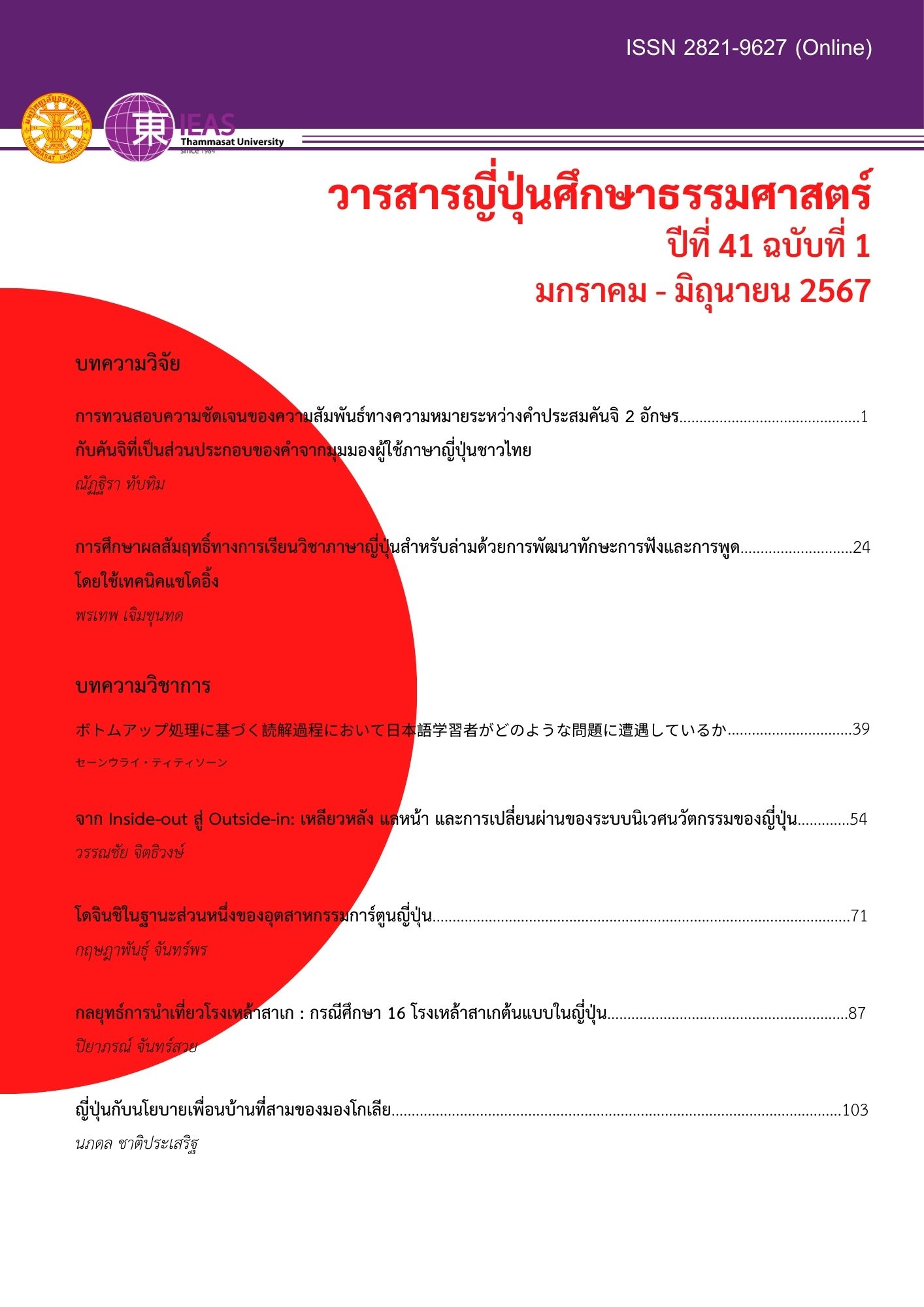What problems do Japanese language learners encounter in the reading process based on bottom-up processing?
Keywords:
Bottom-up processing, Lexical access, Syntactic parsing, Semantic proposition formation, Japanese reading comprehensionAbstract
Bottom-up processing is the basis for processing linguistic information in foreign language reading. It is considered to be a priority. Bottom-up processing requires lower-level processing consisting of lexical access, syntactic analysis, and semantic proposition formation. The following is a summary of the problems encountered by learners of Japanese at each of the lower levels of processing. In the lexical access process, incorrect identification of characters and words can result in incorrect understanding of characters and words. It can also lead to an incorrect understanding of sentences due to the improper separation of strings of characters into words. In the process of syntactic parsing, the fact that certain grammatical items have different functions or uses, or have the same function or use but are expressed in different grammatical items, can make it difficult to understand the meaning. Further, ambiguous or complex structures also affect comprehension and processing time. In the process of forming semantic propositions, the inability to accurately construct meaning is due to the insufficient depth of lexical knowledge. Another factor is the difficulty in reconstructing the meaning of long sentences because they contain so much information that they can no longer be memorized. Finally, the distance between syntactic engagements is far apart, making it difficult to relate the words in a sentence to each other. To address these problems in the future, the authors aim to examine and propose an approach to teaching reading comprehension based on a theoretical framework that takes into account processing at the sentence level and aims to provide a deeper understanding of the meaning of sentences.
Downloads
References
Baddeley, A.D. (2002). Is Working Memory Still Working?. European Psychologist, 7, 85-97.
Grabe, W. & Stoller, F. (2002). Teaching and Researching Reading. Longman.
Grabe, W. & Stoller, F. (2013). Teaching and Researching Reading. Routledge.
Miller, G. A. (1956). The magical number seven, plus or minus two: Some limits on our capacity for processing information. Psychological Review, 63(2), 81–97.
Cowan, N. (2001). The magical number 4 in short-term memory: A reconsideration of mental storage capacity. Behavioral and Brain Sciences, 24(1), 87-114.
Sherrilyn, B.Q. (2021). Difficulties in Learning Japanese as a Foreign Language: The Case of Filipino Learners. BU R&D Journal, 24(2), 31-38.
卯城 祐司 (2009). 英語リーディングの科学―「読めたつもり」の謎を解く 研究社.
苧阪 滿里子 (2002). 脳のメモ帳 ワーキングメモリ 新曜社.
小笠原 信之 (2022). 伝わる!文章力が身につく本 高橋書店.
金井 勇人 (2016). 可能構文におけるニ格主語について-成立条件・許容度・表現効果-. 小出慶一教授退職記念論文集 ことばの本質を求めて,10-25.
小林 由紀 (2005). ガーデンパス文の理解成績と作動記憶容量との関係. 川村学園女子大学研究 紀要, 16(1), 63-76.
サグアンシー タンヤーラット (2016). 外国語としての日本語における読解不安・外国語学習 不安・読解力との関係:タイ人大学生を対象に. 言語科学研究:神田外国語大学紀要, 22,45-64.
柴崎 秀子・時本 真吾・小野 雄一・井上 次夫 (2015). 高校生用集団式日英語リーディングス パンテストの開発および英語における習熟度と作動記憶の関係の検討. 認知心理学研究, 12(2), 101-120.
鈴木 美加 (1990). 文章理解過程のモデルに基づく外国語の読解指導に関する一考察. 日本語 学校論集, 17,67-84.
セーンウライ ティティソーン (2023).タイ人日本語学習者が読解において意味理解を誤る文の 特性」『日本語・日本学研究』13, 東京外国語⼤学国際⽇本研究センター主催サマースクール 研究発表会 夏季セミナー2022『国際⽇本研究への誘い』,258.
寺内 正典 (2010). 認知科学的視点から見たリーディング--大学における望ましい「リーディング の習得と指導」の構築に向けて. 経済志林,77(3) 515-544.
トラン グエン バオ ヴィ (2016). ベトナム人中級学習者の説明文の読解上の問題点―ホーチミン人文社会科学大学日本学部2年生と3年生を例にして―. 日本言語文化研究会論集,12, 111-135.
陳 志文 (2010). 連体修飾句における多重性と語順―中,上級読解の日本語教科書からの分析― 台灣日本語文學報, 27, 175-193.
中島 晶子 (2020). 第2章 非漢字系初級学習者の読解困難点 野田 尚史(編) 日本語教育学 研究8 日本語学習者の読解過程 (pp.27-45). ココ出版.
西崎 友規子・苧阪 満里子 (2004). 文章理解とワーキングメモリの個人差―保持と検索の視点 から. 心理学研究, 75(3), 220-228.
仁子 真裕美. (n.d.).「て形」で文と文をつなげる. 日本語教師の広場. https://www.tomojuku.com/blog/tekei/
野田 尚史 (2016). 第3章 日本語の文の構造とわかりにくさ 野村 雅昭・木村 義之(編) わかりやすい日本語 (pp.35-48). くろしお出版.
はすじょい[@hsjoihs].(2022, January 1). Tweets [構文木の話とか係助詞の挙動の話とかが分かっていると、校正提案をする際に読みづらさの理由を言語化できて便利というのがありますね] [Tweet]. Twitter. https://twitter.com/hsjoihs/status/1481339424009224193
宮外 真理子 (2016). 英語に翻訳しやすい日本語文章作成支援システムの提案. 慶応義塾大学大 学院システムデザイン・マネジメント 研究科.
ポクロフスカ オーリガ (2015). ウクライナ人中級日本語学習者の読解における文字列分節の 課題 一橋日本語教育研究,3, 49-60.
魏 志珍・玉岡 賀津雄 (2011). 中国語を母語とする日本語学習者の日本語テキストの読みにおけ る視点の統一度の影響. 日中言語研究と日本語教育編集委員会編,4,68-77.
渡邊 芙裕美 (2011). 日本語学習者の読解―中上級者のワーキングメモリ容量―. 日本語教育方 法研究会誌18 (2), 38-39.
藤原 未雪(2019).第2章 語彙の読解指導 石黒 圭(編) 日本語教師のための実践・読解指導, (pp.30-45). くろしお出版.
Downloads
Published
Issue
Section
License
Copyright (c) 2024 Thammasat Journal of Japanese Studies

This work is licensed under a Creative Commons Attribution-NonCommercial-NoDerivatives 4.0 International License.




